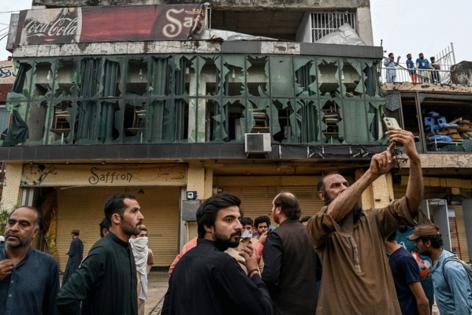Mihir Sharma: How the US gave India and Pakistan an excuse to stand down
Published in Op Eds
When President Donald Trump announced Saturday that India and Pakistan had agreed to a ceasefire, it surprised most on the subcontinent. The military exchanges that followed a terrorist attack on tourists in Kashmir had only intensified in the days prior. And few outsiders seemed interested in the conflict between the two nuclear-armed nations — on Friday, Vice President JD Vance had said that the brewing war was “fundamentally none of our business.”
So how was the Trump administration, unable to arrange for a ceasefire in Ukraine, so successful in South Asia? Even an unenthusiastic attempt at mediation proved remarkably effective. Is the U.S. still the global policeman that it was a couple of decades ago?
Not quite. In this case, America was not a figure of authority — merely a good excuse. Neither India nor Pakistan really wanted a full-out war, but the spiral of attack and retaliation might have led them there. They needed a plausible reason to pull back from the brink, and Washington’s efforts qualified.
All three countries were acting on muscle memory. The U.S. has intervened often when India and Pakistan have fought. In another Kashmir-centric skirmish in 1999, Bill Clinton pushed then-Pakistani Prime Minister Nawaz Sharif into retreating after a stormy July 4 meeting in the Oval Office. Clinton’s advisors told him that would be the most consequential meeting of his presidency; Trump’s advisors may not have been so pressing. But they didn’t need to be. India and Pakistan didn’t have any other path to de-escalation, so they simply seized on the one that had worked before.
Pakistan was particularly grateful for the out, judging by its reaction. Prime Minister Shehbaz Sharif thanked the president for his “pathbreaking leadership and commitment to global peace.” India was less willing to name the U.S. New Delhi didn’t even call it a ceasefire, clumsily describing it as “an understanding on stoppage of firing and military action.” They insisted, in addition, that this was negotiated not at the political level but through talks between the uniformed officers in charge of military operations at the front.
India might have been worried that Trump went too far when he offered to work with the two countries to reach a solution to the Kashmir dispute. New Delhi has never discussed that issue with anyone other than Pakistan, and isn’t likely to start now.
People on this side of the border seem more disappointed than the Pakistanis — egged on, perhaps, by a remarkably irresponsible media. India’s news anchors have predicted total military victory while standing in front of AI-generated images of Pakistani cities on fire, as ersatz air raid sirens shrill in the background.
This bellicosity seemed so universal in the public sphere that you might not have noticed how it contrasted with New Delhi’s official tone. The foreign ministry and the military consistently insisted there would be no escalation. Those who did notice the difference were not pleased. India’s top diplomat, whose frequent press conferences made him the face of this official moderation, had to protect his Twitter account when he and his family began to receive threats.
But Prime Minister Narendra Modi, unlike his Pakistani counterpart, chose to avoid discussing the strikes and counter-strikes at all. This is where even the appearance of U.S. involvement helps: It allows decision-makers at the top to do the right thing while giving them some cover against their own hyper-nationalist followers. People on either side of the border are now free to wonder if somehow their leaders secretly got something in return for giving in to U.S. suggestions that they climb down.
Trump gave that speculation some wings when he talked about “increasing trade” following the ceasefire. Others have wondered about arms deals. No such secret clauses to the agreement may ever materialize, but imagining their existence is nevertheless useful.
Too few facts have been established for either side to credibly claim victory. Eventually, we will know if and how many Indian aircraft were shot down, and how much India damaged Pakistani air bases. The Pakistani air force can say it demonstrated parity in the sky. India can claim to have shown that Pakistani airfields are vulnerable and will be held hostage to terrorist attacks.
It’s all too opaque for any decision-maker to feel confident. Did Pakistan’s Chinese-made missiles really outfox India’s European planes and weaponry? How has the use of drones changed the escalation ladder between two nuclear adversaries, and has it made us less or more secure? Who in the Pakistani establishment aided the terrorist attack on Kashmir, and will they ever be brought to account?
The point of U.S. intervention is to render these questions less urgent. Nobody has to save face by giving in to the other; they each give in to the U.S. — even if America has changed dramatically from the country that could and would enforce its decrees on the rest of the world. If that U.S. didn’t exist, we would have to invent it. These days, we will instead pretend it does.
____
This column reflects the personal views of the author and does not necessarily reflect the opinion of the editorial board or Bloomberg LP and its owners.
Mihir Sharma is a Bloomberg Opinion columnist. A senior fellow at the Observer Research Foundation in New Delhi, he is author of “Restart: The Last Chance for the Indian Economy.”
©2025 Bloomberg L.P. Visit bloomberg.com/opinion. Distributed by Tribune Content Agency, LLC.



























































Comments